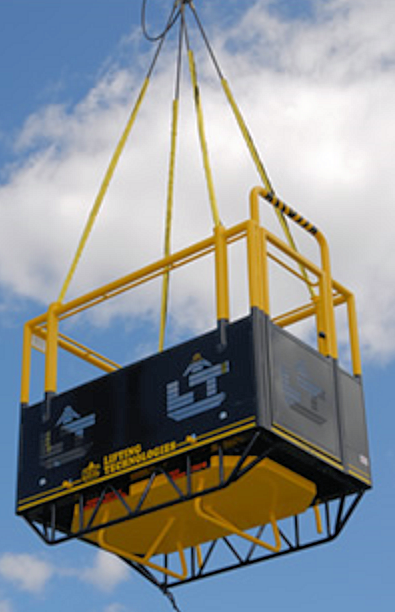Trial Lift and Inspection
A trial lift with the unoccupied personnel platform loaded at least to the anticipated lift weight must be made from ground level, or any other location where employees will enter the platform, to each location at which the platform is to be hoisted and positioned.

Where there is more than one location to be reached from a single set-up position, either individual trial lifts for each location, or a single trial lift, in which the platform is moved sequentially to each location, must be performed; the method selected must be the same as the method that will be used to hoist the personnel.
Immediately after the trial lift, a competent person must visually inspect the equipment, base support or ground, and personnel platform to determine whether the trial lift has exposed any defect or problem or produced any adverse effect. Any condition found during the trial lift and subsequent inspection that fails to meet a requirement of this standard or otherwise creates a safety hazard must be corrected before hoisting personnel.
Critical lifts
OSHA defines a critical lift as a lift that exceeds 75 percent of the rated capacity of the crane or derrick, or requires the use of more than one crane or derrick. The lift must be directed by a person who meets the criteria for both a competent person and a qualified person or by a competent person assisted by one or more qualified persons. Below are examples of critical lifts.
- Lifting Heavy Equipment: When cranes lift extremely heavy equipment, such as large machinery or structural components, it is essential to follow strict safety protocols. This includes ensuring the crane's load capacity is not exceeded and using appropriate rigging techniques.
- Operating in Confined Spaces: Lifts conducted in confined spaces, like between buildings or inside industrial plants, require careful planning and precision. The crane operator must be highly skilled to avoid any contact with nearby structures.
- Lifting People: Sometimes cranes are used to lift personnel in work platforms or baskets. This type of lift requires specialized equipment and additional safety measures to protect the workers.
- Long-Reach Lifts: When a crane needs to extend its boom to great lengths to reach the load, the risk of instability increases. Operators must ensure the crane is properly balanced and the ground is stable to support the extended reach.
- Lifting Over Live Utilities: Performing lifts over live utilities, such as power lines or pipelines, is extremely dangerous. These lifts require thorough planning, including coordination with utility companies and the implementation of strict safety protocols to prevent accidents.
- Multiple Crane Lifts: Sometimes two cranes are used simultaneously to lift a single load. This type of lift requires precise coordination between both crane operators to maintain balance and ensure the load is evenly distributed.
Proof Testing
Prior to hoisting employees on the personnel platform, and after any repair or modification, the platform and rigging must be proof tested to 125 percent of the platform's rated capacity. The proof test may be done concurrently with the trial lift. Personnel hoisting must not be conducted until a competent person determines that the platform and rigging have successfully passed the proof test.
Hoisting Personnel near Power Lines
Hoisting personnel within 20 feet of a power line that is up to 350 kV, and hoisting personnel within 50 feet of a power line that is more than 350 kV, is prohibited (except for power transmission and distribution work).
Knowledge Check Choose the best answer for the question.
2-10. What action must be taken prior to hoisting employees using a platform that has been repaired?
You forgot to answer the question!
